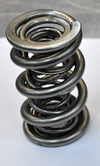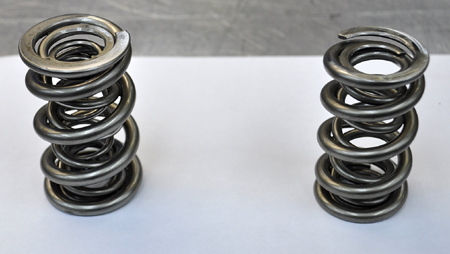Looking for the next power surge
 Known as 'The Professor' for his meticulous preparation and dedication to technological upgrades to his National Hot Rod Association (NHRA) engines, Warren Johnson continues to move forward in his quest to tune the best possible GM DRCE3 Pro Stock engine. Johnson figures he's been working with this particular set-up for the past five years, and cites valve spring life as one of the larger challenges he faces on the 23-race tour.
Known as 'The Professor' for his meticulous preparation and dedication to technological upgrades to his National Hot Rod Association (NHRA) engines, Warren Johnson continues to move forward in his quest to tune the best possible GM DRCE3 Pro Stock engine. Johnson figures he's been working with this particular set-up for the past five years, and cites valve spring life as one of the larger challenges he faces on the 23-race tour.
"The revs on these engines has gone up, and trying to find the ultimate performance level of these things is becoming even more difficult," he says. "You have to realize that these Pro Stock engines, volumetric efficiency-wise, are actually above a Formula One car. We have extreme valve lift, and our valve sizes are bigger. These are not endurance motors - they run full throttle for seven seconds and that's about it."
Because of the short duration involved in a Pro Stock race, Johnson can make a lot of compromises. "These engines run way over an inch of valve lift at the valve, so it's net lift - not gross lift - and we're looking at engine speeds approaching 11,000 rpm. We need to factor those things in. We don't run a lightweight valvetrain," he says.
The life expectancy on Johnson's PSI valve springs is not very good, he tells me. "Valve springs are good for about six to eight runs on the intake side and about ten runs for the exhaust springs. We run triple springs on the intake and dual springs on the exhaust side without any flat-wire damper insert as used in some other racing series. The dual spring uses its self-dampening characteristics and friction dampening, and the triple spring on the intake side uses friction dampening on the spring.
"The weight of the springs contributes to valvetrain weight, and the duration is a lot longer, so the characteristic is valve velocity on the exhaust side," he says. "It is typically less than the intake so we can get by with a lesser spring, so to speak." Some of his compatriots are known for using triple springs on both intake and exhaust, where Johnson feels the double spring on the exhaust side is more than sufficient.
Incredibly, Johnson changes his spring specification on a race-by-race basis. "We change our specifications almost every week. We normally feel the valvetrain is a weak link, so we change the cams," he says.
"If the valve springs aren't breaking, then we're not aggressive enough with the camshaft. There are a lot of things that go hand in hand. It's a continuous process, always changing."

Under what he considers normal conditions, Johnson is going to keep the same valvetrain combination going for any given weekend. "If you change the cylinder head design, con rod or anything that has anything to do with air flow on these engines, you're going to be changing the camshafts, pushrods, roller tappets and so on," he says. Rocker arm ratios are always in change, and rocker materials are always being changed. Our valvetrain specs are in constant development."
Because NHRA stipulates steel for Pro Stock valve springs, it scotched Johnson's revision of using a pneumatic valvetrain in the late 1980s and early 1990s. "I did perfect a pneumatic valvetrain but it's not allowed right now, even though it would probably save each competitor about $50,000 a year," he says.
Johnson is always on the look-out for new valve spring iterations and works closely with his supplier to discover new ways to get the springs to match well with his ever-developing camshaft specification needs.
Fig. 1 - Intake (left) and exhaust valve springs used by Warren Johnson in NHRA Pro Stock competition. Johnson has one victory in the 2010 season to his credit (Photo: Anne Proffit)
Written by Anne Proffit